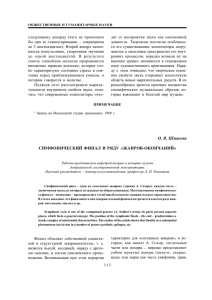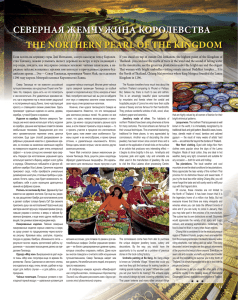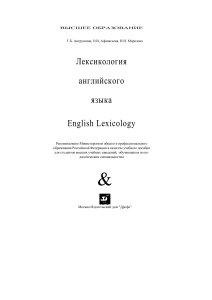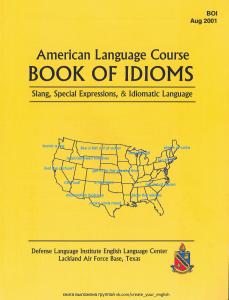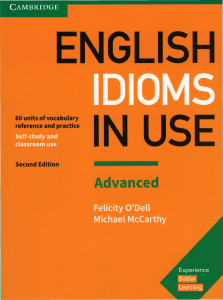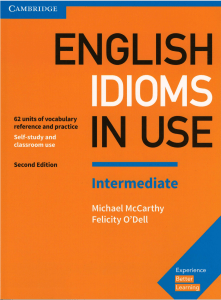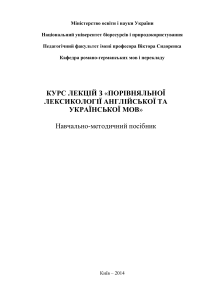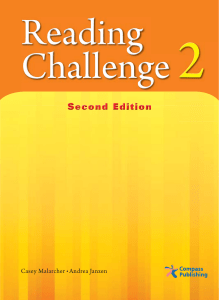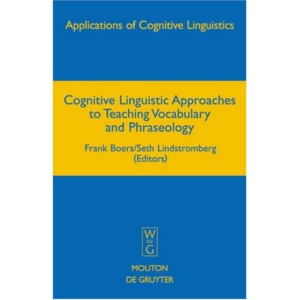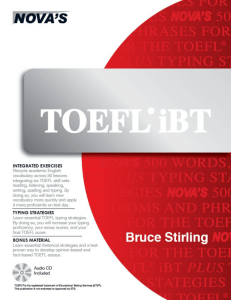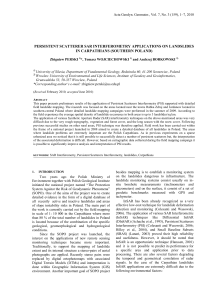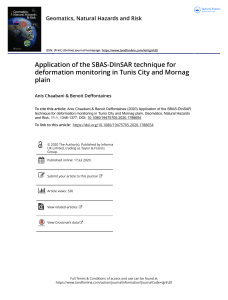Функциональная фразеология в художественном дискурсе
advertisement
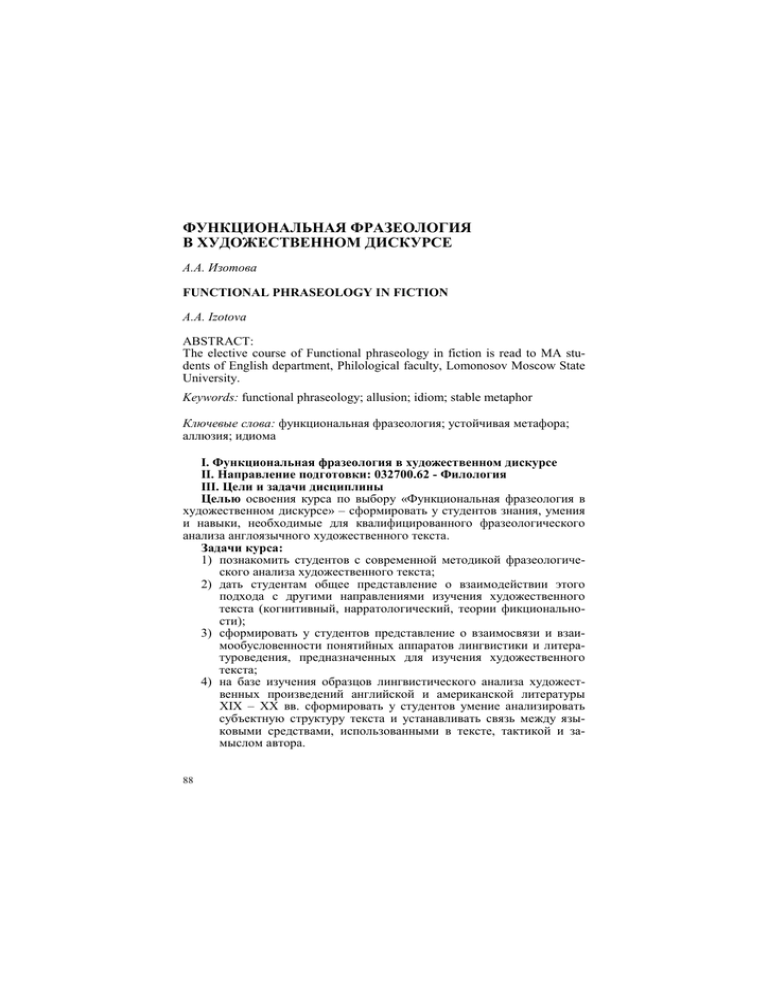
ФУНКЦИОНАЛЬНАЯ ФРАЗЕОЛОГИЯ В ХУДОЖЕСТВЕННОМ ДИСКУРСЕ А.А. Изотова FUNCTIONAL PHRASEOLOGY IN FICTION A.A. Izotova ABSTRACT: The elective course of Functional phraseology in fiction is read to MA students of English department, Philological faculty, Lomonosov Moscow State University. Keywords: functional phraseology; allusion; idiom; stable metaphor Ключевые слова: функциональная фразеология; устойчивая метафора; аллюзия; идиома I. Функциональная фразеология в художественном дискурсе II. Направление подготовки: 032700.62 - Филология III. Цели и задачи дисциплины Целью освоения курса по выбору «Функциональная фразеология в художественном дискурсе» – сформировать у студентов знания, умения и навыки, необходимые для квалифицированного фразеологического анализа англоязычного художественного текста. Задачи курса: 1) познакомить студентов с современной методикой фразеологического анализа художественного текста; 2) дать студентам общее представление о взаимодействии этого подхода с другими направлениями изучения художественного текста (когнитивный, нарратологический, теории фикциональности); 3) сформировать у студентов представление о взаимосвязи и взаимообусловенности понятийных аппаратов лингвистики и литературоведения, предназначенных для изучения художественного текста; 4) на базе изучения образцов лингвистического анализа художественных произведений английской и американской литературы XIX – XX вв. сформировать у студентов умение анализировать субъектную структуру текста и устанавливать связь между языковыми средствами, использованными в тексте, тактикой и замыслом автора. 88 IV. Место дисциплины в структуре ООП 1. Информация об образовательном стандарте и учебном плане: • тип образовательного стандарта и вид учебного плана: интегрированный магистр МГУ; • направление подготовки (в соответствии с образовательным стандартом): «филология» ; • наименование учебного плана: «филология»; • профиль подготовки / специализация / магистерская программа: «Английский язык: функционально-коммуникативный и социопрагматический аспекты изучения английского языка» 2. Информация о месте дисциплины в образовательном стандарте и учебном плане: • вариативная часть, профессиональный цикл, курс по выбору. 3. Перечень дисциплин, которые должны быть освоены до начала освоения данной дисциплины: «Английский язык» на уровне подготовки бакалавра филологии по ОС МГУ, «История зарубежной литературы» на уровне подготовки бакалавра филологии по ОС МГУ или ФГОС. 4. Общая трудоемкость дисциплины составляет 2 единицы или 64 академических часа (32 аудиторных часа, 32 часа самостоятельной работы студентов) 5. Форма промежуточной аттестации – зачет. V. Формы проведения: • форма занятий с указанием суммарной трудоемкости по каждой форме: лекции – 16 ауд.ч.; практические занятия (семинары) – 16 ауд.ч.; самостоятельная работа – 32 ауд.ч.; • формы текущего контроля – коллоквиумы VI. Распределение трудоемкости по темам, а также формам проведения занятий с указанием форм текущего контроля и промежуточной аттестации: Трудоемкость (в академических часах) по формам занятий (для Наименование Формы дисциплин) и видам работ (для разделов и тем конпрактик) дисциплины троля Аудиторная работа (с Самостояразбивкой по формам тельная и видам) работа Лекции Семинары 1. Предмет идиома2 2 4 коллоктической фразеовиум логии 2 4 коллок2. Фразеологические 2 виум единицы и устой89 3. 4. 5. 6. чивые метафоры Обыгрывание идиом как лингвистическая проблема Метаметафора как текстологическая проблема Просодия устойчивой метафоры Обыгрывание устойчивых метафор как раздел филологической герменевтики Итого 2 2 4 коллоквиум 4 4 8 коллоквиум 2 2 4 4 4 8 коллоквиум коллоквиум 16 16 32 VII. Содержание дисциплины по темам – аудиторная и самостоятельная работа: Тема 1. Предмет идиоматической фразеологии. Содержание темы: According to academician V.V. Vinogradov a phraseological unit is a combination of words which are semantically integral in the sense that the meaning of the whole is not deducible from the meanings of the constituent parts. This is often termed as idiomaticity. It is necessary to take into account structural separability of components: on the content plane a phraseological unit is indivisible, on the expression plane - it is separable. Being a readymade block, a phraseological unit functions as an equivalent of a word. According to one of the traditionally accepted classifications all phraseological combinations of English are divided into two main groups or categories: 1) phraseological units or phraseological units-collocations (British phraseology); 2) idioms proper — the units which do not only denote a certain object or a phenomenon but also have an implicit evaluation. The dichotomy of phraseological combinations manifests the difference between stylistically neutral phraseological units and those which are based on a metaphor. Задания для самостоятельной работы: • What is the subject of idiomatic phraseology? Use the Web. • How can you define a phraseological unit? Use the Web. • What is the traditional division of English phraseological combinations and what does this dichotomy manifest? Use the Web. Тема 2. Фразеологические единицы и устойчивые метафоры Содержание темы: 90 The specific stylistic connotations of idioms proper arise from the semantic peculiarities these units are characterized by. Idioms proper are based on the metaphoric transference of meaning and are often regarded as “metaphors”. In contrast with an individual (occasional) metaphor which is always created for the nonce and forms part of the poetical language, the metaphor that underlies an idiom proper is “dead”. This is something that has become part of the English usage (языкового узуса) and is at a disposal of every speaker of English. That is why at the English department of the philological faculty of Moscow State University a new term “stable (or fixed) metaphor” (устойчивая метафора) has been suggested and introduced. In the present manual both terms “idiom proper” and “stable metaphor” will be employed. Although the group of stable or fixed metaphors is a homogeneous category, certain types of units can be singled out within this class. Thus, some idioms are perceived as quite concrete facts of the language (e. g. no man’s land - ‘a place or situation of uncertainty or danger’); others have allusive character, they are often linked with a literary source and go back to the famous literary quotations. For example, such phrases as to sell one's birthright for a mess of pottage (‘to exchange something of lasting value for something that is of value for a short time only’), to kill the fatted calf (‘to do all one can to provide plenty of good food and drink, esp. to have a feast to welcome someone’), a land of milk and honey (‘a place in which life would be pleasant, with plenty of food and chances of success and happiness’), a thorn in someone's flesh (‘a person or thing that causes continuous trouble or anxiety to someone’), an eye for an eye and a tooth for a tooth (‘a punishment that is as cruel as the crime’), a fly in the ointment (‘something or someone that spoils plans, causes trouble or lowers the value of something’) go back to the Bible and therefore are referred to as biblical idioms. We should also mention a wide variety of idioms, which have a different origin, they came into modern English from the works and plays of W. Shakespeare. These phrases are registered by dictionaries as Shakespearian idioms. Задания для самостоятельной работы: • What is an idiom proper or a “stable metaphor” and in what way does it differ from a neutral phraseological unit? Use the Web. • Why was the new term “stable or fixed metaphor” suggested and introduced at the English department of the philological faculty of Moscow State University? Use the Web. • What types of units can be singled out within the group or the category of stable metaphors? Give examples. Use the Web. Тема 3. Обыгрывание идиом как лингвистическая проблема Содержание темы: The term “deformation” is not the only metalinguistic means to refer to this phenomenon, there also exist such terms as “nonce-variation”, “occasional use”, “linguistic transformation”, which designate the same thing. We believe that the term “deformation” is the most acceptable one because it renders the peculiarities of the processes which take place when an idiom is 91 actually broken in speech, and then refashioned or even remoulded as the case may be. Deformation as the ontological property of all phraseological units is possible owing to the specific linguistic properties of idioms, which are structurally separable on the one hand, and semantically global on the other. It takes place when an idiom that is fixed in the language and forms part of its wordstock is rebuilt and its components take on a life of their own. It is a process in which both the structural and the semantic properties of the given linguistic unit are involved. Deformation of an idiom proper should be kept distinct from all kinds of mistakes, i.e. from those cases when the speaker confuses two idioms, erroneously substitutes one component of a phraseological unit for another word, or makes mistakes in the choice of articles, and so on and so forth. One should always bear in mind that deformation is done on purpose: the speaker is always aware of the fact that he is using an idiom facetiously. Deformation should also be kept distinct from acceptable variation as in give smb an inch and he will take a mile (a yard), (an ell), a holy / sacred cow; as thick as a cable / hailstones / blackberries; chilled / frozen to the bone / marrow. Here, we want to point out that some idioms permit the use of passive constructions: to let the cat out of the bag — the cat is let out of the bag; to pull someone's leg — someone's leg is pulled. When acceptable variation is found it is characteristically registered by phraseological dictionaries. Sometimes variants can be connected with the territorial indication, e. g. the skeleton in the cupboard (British English) — the skeleton in the closet (American English). As for idioms which are sentence-like, that is proverbs, they are often shortened. It is felt sufficient to hint at the whole by the use of a part, as in such cases as a stitch in time (a stitch in time saves nine = ‘damage quickly worsens if it is not repaired; the mending of a fault as soon as it is noticed will save much time, cost and trouble’). Sometimes, as we know, the fragment may take on a life of its own as an independent idiom, e. g. an early bird (the early bird catches the worm = ‘the person who gets up early to work will be successful’). It may coexist for some time with the saying which has given rise to it and is often granted a separate entry in phraseological dictionaries. It should be noted that most if not all idioms exhibit certain transformational deficiencies. The functioning of phraseological units is influenced by the restrictions of a paradigmatic character which condition the syntactic deficiency of idioms. Задания для самостоятельной работы: • Find and comment the cases of Substitution of one or more components of an idiom. • Find and comment the cases of Insertion. • Find and comment the cases of Ellipsis. • Find and comment the cases of Contamination. 92 • Find and comment the cases of Double Actualization. Тема 4. Метаметафора как текстологическая проблема Содержание темы: Idioms proper as “usual” or “dead” metaphors are made to serve as the starting point in creating a new highly individual and original metaphor or “metametaphor”. To clarify the point, let us turn to the following example: “I got it from the horse’s mouth, Grosset said. “You're quitting Dee Cee at the end of the mouth” “Who's the horse this time?” “Mr. Duncan Calderwood” (I. Shaw. Rich Man, Poor Man). In the first sentence of the given extract the idiom proper from the horse's mouth (‘from the person most closely concerned with the subject, being discussed’) is not disturbed. It is only a few lines below that we come across the word horse which is obviously connected with it. It is quite clear from the context that the word horse here does not denote ‘a domestic animal’. To understand its meaning one has to turn to the idiom proper we find in the opening sentence, its meaning is obviously derived from that of the idiom proper under consideration. The specific meaning of the word “horse” in the present context becomes more concrete when “the source of information” is actually named and the reader learns that it happened to be a man called Mr. Calderwood. Thus, we may conclude that the idiom proper as “a usual metaphor” gives rise to “the metametaphor” which is realized in the given text. As follows from the example adduced above, the major elements of the “metametaphor” are not only the idiom proper itself and its components but other units of the text as well, the image being developed and “adjusted” as it were to the given situation. From what has been said follows that “metametaphor” is a textological problem. Its “linguistic mechanism” can be understood only when idioms proper are regarded within a certain chunk of speech i.e. when the broader textological environment is taken into account. Задания для самостоятельной работы: Comment “metametaphors” in the following fragments: • • • Mr. Pott winced beneath the contemptuous gaze of his wife. He had made a desperate struggle to screw up his courage, but it was fast coming unscrewed again [screw up one's courage = ‘to force oneself to be brave’]. (Ch. Dickens. Pickwick Papers). I had expected to freeze her young - or, rather, middle-aged blood, and she hadn't moved a muscle [freeze someone's blood = ‘cause somebody to feel great fear or terror’]. (P. G.Wodehouse. Jeeves in the Offing). “You only said the one thing you should not have said”, he replied bleakly. “You merely put your foot in it right up to the knee [put one's foot in it (coll) = ‘to do or say something that 93 distresses or offends another person’] (P. G. Wodehouse. Summer Moonshine). • April June stamped what, if I hadn't felt it on my trouser seat, I would have called a dainty foot [stamp one's foot = ‘to express anger or great annoyance esp. by putting one's foot down’]. (P. G. Wodehouse. Laughing Gas) • ... He wanted any first-hand impressions you had of Melpham. I told him you could only have been in long clothes or whatever they put babies into in 1912, but apparently you were there. You look so distinguished, Gerald, one can't tell what age you are [in long clothes = ‘still a young baby’]. (A.Wilson. AngloSaxon Attitudes) Тема 5. Просодия устойчивой метафоры Содержание темы: It is common knowledge that different punctuation marks for the horizontal segmentation of the flow of speech such as double commas and dashes, double and single quotes, brackets, Italics and Spacing have their exact prosodic arrangement. This forms the basis for the study of the character of bringing out various units in the flow of speech. As is well-known, the horizontal segmentation of a text consists in dividing it into different layers. This can be achieved not only with the help of punctuation marks, but also by means of diapason. In connection with what has been said above a question is bound to arise — what is the prosodic arrangement of this or that linguistic unit if it is not marked by punctuation marks in the author’s speech and what are the basic rules of the horizontal segmentation of stable metaphors? However, as a rule, stable metaphors are not singled out in the written form of speech both in those cases when they are used in their dictionary form, and when they are deformed, and one, in fact, comes across its fragments. What are then the basic peculiarities of the prosodic arrangement of dictionary forms of stable metaphors and their deformed counterparts, how are they to be reflected in our inner speech if we deal with written texts? As has already been mentioned, a stable metaphor is a usual metaphor (узуальная метафора) which is based on the metaphoric transference of meaning. Thus, a stable metaphor is likely to require the use of suprasyntactic timbre, i.e. the employment of those suprasegmental parameters which are meant to show a metasemiotic character of this unit (e.g. tempo, diapason, loudness, voice-quality, etc.). Having analyzed a considerable corpus of material, we came to the conclusion that the prosody of a usual stable metaphor is characterized, as a rule, by pausation and slow tempo. As far as deformed variants of the same stable metaphors are concerned, they call for the use of suprasyntactic timbre, i.e. the employment of paralinguistic parameters, such as pitch-movement, pausation, tempo, loudness, diapason and voice-quality. Moreover, the prosody of a usual stable metaphor appears to be similar to a specific background against which various metaphors are extended in the case of deformation. 94 Задания для самостоятельной работы: • The importance to study the prosody of a stable metaphor? • The way stable metaphors can be singled out in a written text? • The way one can you characterize the prosodic arrangement of a stable metaphor used in its dictionary form. • The way the prosody of deformed stable metaphors. Тема 6. Обыгрывание устойчивых метафор как раздел филологической герменевтики Содержание темы: The existence of two ways of reproducing a stable metaphor in speech, namely the use of a corresponding unit in its dictionary or deformed form makes it necessary to regard this opposition in terms of philological hermeneutics — a domain of the humanities dealing with understanding and interpretation of a text. Therefore it is an urgent task to study the following criteria: who deforms a stable metaphor and who uses it in its dictionary form, in what speech situations does deformation take place, what is the goal that the speaker is seeking to achieve when he deliberately deforms a stable metaphor in his speech and how can we evaluate this deformation from the point of view of appropriateness and aesthetic value of this device in this or that context. “Idioms form an extremely important — an inseparable — part of a language; its very core, its essence, its last resort. But certain idioms have been so widely and so much used, often so indiscriminately used, that they have lost their freshness, their picturesqueness, their point; from being vivid metaphors they have become mere counters and a source of confusion”. That is why these units are regularly played upon. The wide spreading of deformation of stable metaphors in English fiction is closely connected with national cultural-historical peculiarities of the development of the English language. The tradition of word-play in general, as well as the use of metaphorical units of the language to create new images goes back to the works of such great English writers as W. Shakespeare, J. Swift, L. Sterne. The eminent English writers and poets not only created various metaphors, which, having been widely spread in the language, enriched it and became part of its lexicon, but also not infrequently used deformation of already fixed idioms that resulted in the creation of metasemiotic processes and consequently “metametaphors”. Задания для самостоятельной работы: • The attitude towards idioms in the 18th century and in what way did it change in the 19th century. • The peculiarities of reproducing stable metaphors in the novels by J. Galsworthy. • The importance to distinguish between the author's speech and the speech of a literary character in the style of fiction. • The peculiarities of the usage of stable metaphors in the 20th century novel, e. g. in the novels by A. Wilson, J. Wain, I. Murdoch. 95 • The sociolinguistic factors the phenomenon of deformation is connected with. • The way one can formulate the concept of meta-folklore. VIII. Перечень компетенций, формируемых в результате освоения дисциплины / прохождения практики – по видам компетенций 1. Универсальные компетенции: а) общенаучные: • способность анализировать и оценивать философские проблемы при решении социальных и профессиональных задач (М-ОНК-1); • способность самостоятельно формулировать научные проблемы на основе адекватного анализа научной традиции и современных тенденций (М-ОНК-2); • способность к самостоятельному пополнению, критическому анализу и применению теоретических и практических знаний в сфере гуманитарных наук для собственных научных исследований и практической деятельности (М-ОНК3). б) инструментальные: • владение иностранным языком в устной и письменной форме для осуществления коммуникации в учебной, научной, профессиональной и социально-культурной сферах общения; владение терминологией специальности на иностранном языке; умение готовить публикации, проводить презентации, вести дискуссии и защищать представленную работу на иностранном языке (М-ИК-1); • владение основными методами, способами и средствами получения, хранения, переработки информации; умение анализировать и совершенствовать методы, способы и средства работы с информацией в соответствии с поставленными задачами (М-ИК-3). в) системные: • способность к творчеству, порождению инновационных идей, выдвижению самостоятельных гипотез (М-СК-1); • способность к поиску, критическому анализу, обобщению и систематизации научной информации, к постановке целей исследования и выбору оптимальных путей и методов их достижения (М-СК-2); • способность к самостоятельному обучению и разработке новых методов исследования, к изменению научного и научно-производственного профиля деятельности; к инновационной научно-образовательной деятельности (М-СК-3); 2. Профессиональные компетенции 96 • знание актуальных проблем, традиционных и современных методов филологической науки, понимание структуры и перспектив развития филологии как области знаний, междисциплинарных связей филологии (М-ПК-1); • владение категориально-терминологическим аппаратом современной филологии; знание важнейших филологических отечественных и зарубежных научных школ (М-ПК-2); • владение навыками самостоятельного филологического исследования и аргументированного представления его результатов (М-ПК-3); • владение навыками квалифицированного анализа, комментирования, реферирования и обобщения результатов научных исследований с использованием современных методик и методологий, передового отечественного и зарубежного опыта (М-ПК-4); • владение навыками квалифицированной филологической экспертизы, критики, интерпретации, комментария и анализа различных типов текстов (М-ПК-5); • способность с филологической и общегуманитарной точки зрения осмыслять, описывать и анализировать разнообразные феномены языка, литературы, культуры, сознания, общественной жизни (тексты, произведения, ситуации, процессы и т.п.) (М-ПК-6); • умение применять филологическую теорию в прикладных областях (М-ПК-7). IX. Используемые образовательные, научно-исследовательские и научно-производственные технологии 1. Образовательные технологии: интерактивные лекционные занятия с презентационным сопровождением, аналитическое чтение научной литературы, изучение образцов анализа, выполнение практических заданий. 2. Научно-исследовательские технологии: сопоставительный анализ, изучение научной литературы. X. Учебно-методическое обеспечение самостоятельной работы студентов, оценочные средства контроля успеваемости и промежуточной аттестации 1. Учебно-методические рекомендации для обеспечения самостоятельной работы студентов. Sometimes we cannot imagine ourselves not using an idiom, not expressing ourselves in the idiomatic way; and there are plenty of such situations. “Idiom … is, in truth, the life and spirit of language. It may be regarded as the sister of poetry, for like poetry, it retranslates our concepts into living experiences and breathes the atmosphere of animal sensation which sustains the poet in his flights”. That is how the British linguist L. P. Smith describes an idiom. It is a well-known fact that idiomatic phraseology as a linguistic 97 discipline is an integral part of lexicology which studies stable combinations of words. The main unit of idiomatic phraseology is a phraseological unit. How can we define a phraseological unit? According to academician V. V. Vinogradov a phraseological unit is a combination of words which are semantically integral in the sense that the meaning of the whole is not deducible from the meanings of the constituent parts. This is often termed as idiomaticity. It is necessary to take into account structural separability of components: on the content plane a phraseological unit is indivisible, on the expression plane — it is separable. Being a ready-made block, a phraseological unit functions as an equivalent of a word. It should be noted in this connection that at the English department of the philological faculty of Moscow State University the study of idiomatic phraseology is based on the categorial approach. By definition a category is something which is derived from a vast number of individual cases to stress a certain general feature. The categorial approach enables us to see phraseological units from different points of view; to correlate their ontological characteristics and the way they actually function in speech. 2. Примерный список заданий для проведения текущей и промежуточной аттестации (темы для докладов, рефератов, презентаций и др.). • The Subject of Idiomatic Phraseology. • Phraseological Units and Stable Metaphors. • Deformation of Idioms as a Linguistic Problem. • “Metametaphor” as a Textological Problem. • The Prosody of a Stable Metaphor. • Deformation of stable metaphors as part of philological hermeneutics 3. Примерный список вопросов для зачета: • What is one of the complex devices which is widely discussed in the papers of professor A. V. Kunin's phraseological school of thought? Can you specify different types of this device? • What can be said about “potential words” in connection with the meaning of an idiom? • What can you say about the term “inner form” with reference to idiomatic phraseology? • What is the term “metametaphor” used to describe in this manual? In what way are “metametaphors” different from “usual”, “dead” metaphors? • What is the first type of deformation of an idiom proper “metametaphor” can be based on? • How can you describe the other way of creating “metametaphor” in a text? • What happens to an idiom when “metametaphor” turns out to be the result of the interaction of the two processes mentioned above? 98 • In what way can you prove that “metametaphor” is a textological problem? XI. Учебно-методическое и информационное обеспечение дисциплины: 1. Основная литература • Виноградов В.В. Избранные труды. Лексикология и лексикография. М., 1977. • Изотова А.А. Английская фразеология: Аллюзии. Идиомы. Метафоры. – М., 2014. • Чинёнова Л.А. Английская фразеология в языке и речи. – М., 1986. • Izotova A. English Idioms: Usage and Tradition. – М., 2001. • Izotova A. English idiomatic phraseology in fiction. – M., 1998. • Longman Dictionary of English Idioms. – Bath: The Pitman Press, 1980. 2. Дополнительная литература • Ахманова О.С. Словарь лингвистических терминов. М., 1966 • Изотова А.А. Обыгрывание английских фразеологических единиц в речи. – М., 1994. • Cowie A. P., Mackin R. Oxford Dictionary of Current Idiomatic English. Vol. 2. – London, Oxford University Press, 1983. 3. Программное обеспечение и Интернет-ресурсы • http://www.philol.msu.ru/~slavphil/books/jsk_index.html XII. Материально-техническое обеспечение дисциплины • доступность указанной литературы; • доступ к Интернет-ресурсам. Программа составлена в соответствии с требованиями ОС МГУ по специальности / направлению подготовки «Филология». Литература / References Ахманова О.С. Словарь лингвистических терминов. М., 1966 Виноградов В.В. Избранные труды. Лексикология и лексикография. М., 1977. Изотова А.А. Обыгрывание английских фразеологических единиц в речи. – М., 1994. Изотова А.А. Английская фразеология: Аллюзии. Идиомы. Метафоры. – М., 2014. Чинёнова Л.А. Английская фразеология в языке и речи. – М., 1986. Izotova A. English Idioms: Usage and Tradition. – М., 2001. Izotova A. English idiomatic phraseology in fiction. – M., 1998. Longman Dictionary of English Idioms. – Bath: The Pitman Press, 1980. Cowie A. P., Mackin R. Oxford Dictionary of Current Idiomatic English. Vol. 2. – London, Oxford University Press, 1983. Язык, сознание, коммуникация: Сб. статей / Отв. ред. В.В. Красных, А.И. Изотов. – М.: МАКС Пресс, 2014. – Вып. 49. – 100 с. ISBN 978-5-317-04870-9 99
